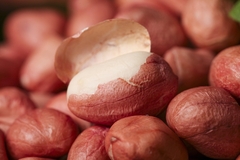Scientists create more stable microparticles to unlock iron-fortified foods
US researchers have developed a new way to fortify foods and beverages with iron using crystalline microparticles — structures that combine the mineral with organic molecules for improved stability. These can be sprinkled on food and added to staple foods like bread or drinks like coffee and tea. The particles could also be adapted to carry other critical minerals, such as zinc, calcium, or magnesium.
The Massachusetts Institute of Technology (MIT) scientists believe their solution can help fight malnutrition, as around two billion people worldwide suffer from iron deficiency. This condition can lead to anemia, impaired brain development in children, and increased infant mortality.
“We’re creating a solution that can be seamlessly added to staple foods across different regions,” says Ana Jaklenec, a principal investigator at MIT’s Koch Institute for Integrative Cancer Research.
“What’s considered a staple in Senegal isn’t the same as in India or the US, so our goal was to develop something that doesn’t react with the food itself. That way, we don’t have to reformulate for every context — it can be incorporated into a wide range of foods and beverages without compromise.”

Food fortification challenges
Although food fortification can help combat nutrient deficiencies, it is often challenging, as many nutrients break down during storage or cooking. For example, when added to foods, iron can react with other molecules and give the product a metallic taste.
Previously, Jaklenec and her lab demonstrated that encapsulating nutrients in polymers can protect them from reacting with other molecules or breaking down. A small clinical trial found that women could absorb the iron from bread fortified with the encapsulated mineral. However, using a polymer adds a lot of bulk to the material, which limits its uses.
 Iron deficiency is one of the main causes of anemia, which the WHO estimates affects 40% of children aged 6–59 months and 30% of women aged 15–49.“Encapsulating iron in polymers significantly improves its stability and reactivity, making it easier to add to food,” explains Jaklenec. “But to be effective, it requires a substantial amount of polymer. That limits how much iron you can deliver in a typical serving, making it difficult to meet daily nutritional targets through fortified foods alone.”
Iron deficiency is one of the main causes of anemia, which the WHO estimates affects 40% of children aged 6–59 months and 30% of women aged 15–49.“Encapsulating iron in polymers significantly improves its stability and reactivity, making it easier to add to food,” explains Jaklenec. “But to be effective, it requires a substantial amount of polymer. That limits how much iron you can deliver in a typical serving, making it difficult to meet daily nutritional targets through fortified foods alone.”
Instead, MIT postdoctoral researcher Xin Yang proposed using iron as a metal-organic framework building block. This crystalline particle consists of metal atoms joined by organic molecules (ligands) to create a rigid, metal-like structure. Depending on the combination of metals and molecules, it can be used for various applications.
“We thought maybe we could synthesize a metal-organic framework with food-grade ligands and micronutrients,” says Yang. “Metal-organic frameworks have very high porosity, so that they can load a lot of cargo. That’s why we thought we could leverage this platform to make a new metal-organic framework that could be used in the food industry.”
Stabilizing iron
For their study in Matter, the researchers developed particles where iron is bound to fumaric acid, which is often used in foods to enhance flavor or aid preservation.
This structure prevents iron from reacting with polyphenols, ensuring they can be absorbed in the body. Polyphenols are plant-based compounds with antioxidant properties commonly found in foods like whole grains, nuts, coffee, and tea.
The framework remains stable until it reaches an acidic environment, like the stomach, where it breaks down and releases iron.
 As iodized salts are successful at preventing iodine deficiency, research is ongoing to create “double-fortified salts” with iodine and iron.“We are very excited about this new approach and what we believe is a novel application of metal-organic frameworks to potentially advance nutrition, particularly in the developing world,” says Robert Langer, professor at MIT and a member of the Koch Institute.
As iodized salts are successful at preventing iodine deficiency, research is ongoing to create “double-fortified salts” with iodine and iron.“We are very excited about this new approach and what we believe is a novel application of metal-organic frameworks to potentially advance nutrition, particularly in the developing world,” says Robert Langer, professor at MIT and a member of the Koch Institute.
Added benefits
The researchers included another critical nutrient, iodine, in their metal-organic framework particles. They note that iodized salts have been successful at preventing iodine deficiency and point to ongoing research to create “double-fortified salts” with iodine and iron.
It is challenging to deliver these nutrients in one product, as iron and iodine can react with each other, making both less likely to be absorbed. However, the MIT team demonstrated they could load their iron-containing metal-organic framework with iodine without the compounds reacting.
Tests also demonstrated the particles’ stability — the frameworks with iron and iodine could withstand long-term storage, high heat, high humidity, and boiling water. Throughout these tests, the particles retained their structure.
Moreover, when fed to mice, the researchers found that iron and iodine were in the animals’ bloodstream within several hours of consumption.
As the next step, the researchers plan to launch a company to develop coffee and other beverages fortified with iron and iodine. They also aim to continue developing a double-fortified salt that people can consume on its own or that manufacturers can incorporate into staple foods.















